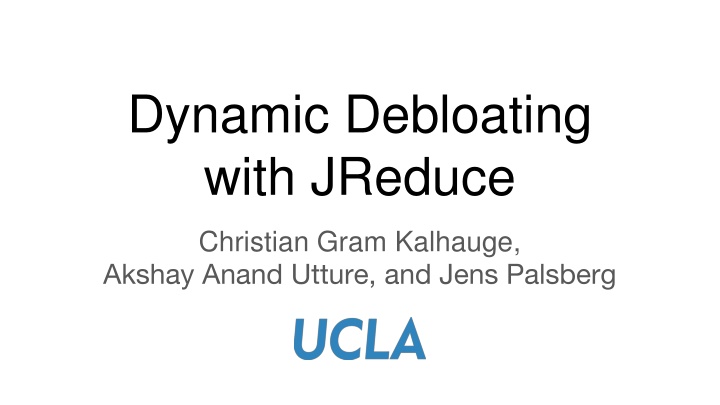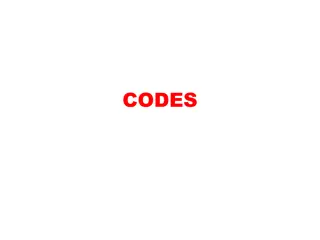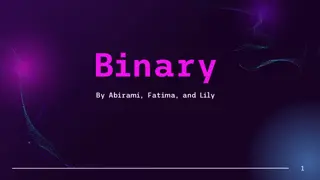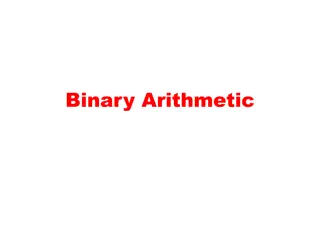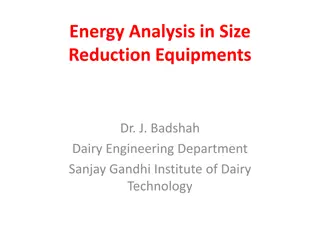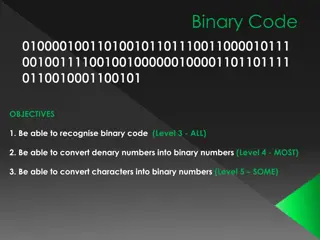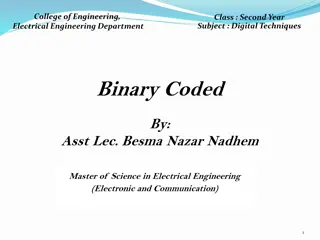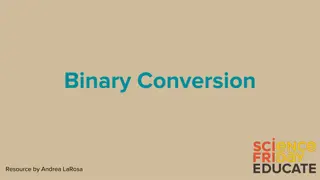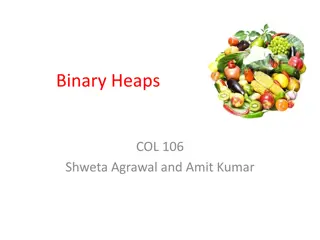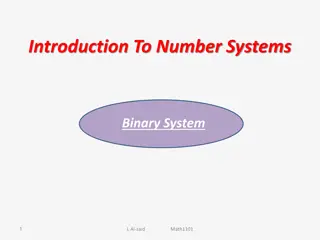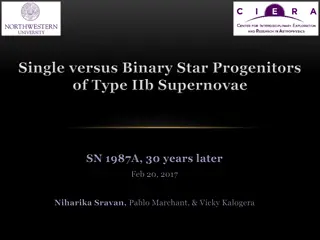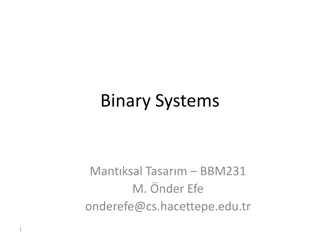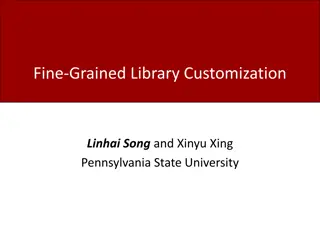Dynamic Debloating with JReduce - Binary Reduction for Efficient Program Analysis
Combining dynamic runs with static information improves program analysis performance and accuracy in Dynamic Debloating with JReduce. This approach utilizes logical dependencies to reduce binary size efficiently, addressing challenges posed by static analysis limitations. The process enhances both speed and effectiveness by 5x and 12x respectively, offering a promising solution for program optimization.
Download Presentation

Please find below an Image/Link to download the presentation.
The content on the website is provided AS IS for your information and personal use only. It may not be sold, licensed, or shared on other websites without obtaining consent from the author.If you encounter any issues during the download, it is possible that the publisher has removed the file from their server.
You are allowed to download the files provided on this website for personal or commercial use, subject to the condition that they are used lawfully. All files are the property of their respective owners.
The content on the website is provided AS IS for your information and personal use only. It may not be sold, licensed, or shared on other websites without obtaining consent from the author.
E N D
Presentation Transcript
Dynamic Debloating with JReduce Christian Gram Kalhauge, Akshay Anand Utture, and Jens Palsberg
Dynamic Debloating with JReduce 1. Why: Static analysis is neither sound nor complete and dynamic debloating is slow. 2. What: Combining dynamic runs with static information is 5x better and 12x faster. 3. How: Binary reduction with logical dependencies.
Dynamic Debloating with JReduce 1. Why: Static analysis is neither sound nor complete and dynamic debloating is slow. 2. What: Combining dynamic runs with static information is 5x better and 12x faster. 3. How: Binary reduction with logical dependencies.
Java Program Reflection Dynamic library loading Incomplete type system ... CRASH Program Entry Static Closure
"[V]irtually all published whole-program analyses are unsound and omit conservative handling of common language features when applied to real programming languages." Livshits, Benjamin, et al. "In defense of soundiness: a manifesto." Communications of the ACM 58.2 (2015): 44-46.
Dynamic Debloating Bytecode Java Test Suite Program Test Suite Java Cons: Pros: Only code covered by test remains Tests have to be executable Slow Natural user defined inclusion criteria Well defined success Resistant to dynamic features
Why is it slow? Invalid Programs Flaky Results Program Test Suite
Why is it slow? ( ( ( ( 1 2 3 ) ) ) )
Why is it slow? ( ( ( ( 1 2
Why is it slow? 3 ) ) ) )
Why is it slow? ( ( ( ( 1 2 3 ) ) ) )
45 iterations No reduction ddmin:
Dynamic Debloating with JReduce 1. Why: Static analysis is neither sound nor complete and dynamic debloating is slow. 2. What: Combining dynamic runs with static information is 5x better and 12x faster. 3. How: Binary reduction with logical dependencies.
Dynamic Debloating with JReduce 1. Why: Static analysis is neither sound nor complete and dynamic debloating is slow. 2. What: Combining dynamic runs with static information is 5x better and 12x faster. 3. How: Binary reduction with logical dependencies.
( ( ( ( ) ) ) ) 1 2 3
( ( ( ( ) ) ) 1 2 3
( ( ( ) ) ) 1 2 3
Java program Dynamic search over valid subprograms CRASH Program entry Static closure
(syntax) (files, lines) Items Trees Graphs (ddmin) (hdd) , (perses) (Old J-Reduce)
12x faster When Encoding Dependencies between Classes
class A implements I { String m () { /* */ } B n() { ... } } class B implements I { String m () { ... } B n() { ... } } interface I { String m(); B n(); } class A implements I { String m () { /* */ } B n() { ... } } class B implements I { String m () { ... } B n() { ... } } interface I { String m(); B n(); } } class A implements I { String m () { /* */ } B n() { ... } } class B implements I { String m () { ... } B n() { ... } } interface I { String m(); B n(); REDUCE class M { String x(I a) { return a.m(); /* */ } String main() { return new M().x(new A()); /* */ } }
Class-based [1] [1] Kalhauge, Christian Gram, and Jens Palsberg. "Binary reduction of dependency graphs." Proceedings of the 2019 27th ACM Joint Meeting on European Software Engineering Conference and Symposium on the Foundations of Software Engineering. 2019. [2] Kalhauge, Christian Gram, and Jens Palsberg. "Logical bytecode reduction." Proceedings of the 42nd ACM SIGPLAN International Conference on Programming Language Design and Implementation. 2021.
Class-based [1] Fine-grained [2] [1] Kalhauge, Christian Gram, and Jens Palsberg. "Binary reduction of dependency graphs." Proceedings of the 2019 27th ACM Joint Meeting on European Software Engineering Conference and Symposium on the Foundations of Software Engineering. 2019. [2] Kalhauge, Christian Gram, and Jens Palsberg. "Logical bytecode reduction." Proceedings of the 42nd ACM SIGPLAN International Conference on Programming Language Design and Implementation. 2021.
Class-based [1] Fine-grained [2] [1] Kalhauge, Christian Gram, and Jens Palsberg. "Binary reduction of dependency graphs." Proceedings of the 2019 27th ACM Joint Meeting on European Software Engineering Conference and Symposium on the Foundations of Software Engineering. 2019. [2] Kalhauge, Christian Gram, and Jens Palsberg. "Logical bytecode reduction." Proceedings of the 42nd ACM SIGPLAN International Conference on Programming Language Design and Implementation. 2021.
Class-based [1] Fine-grained [2] 10:00 [1] Kalhauge, Christian Gram, and Jens Palsberg. "Binary reduction of dependency graphs." Proceedings of the 2019 27th ACM Joint Meeting on European Software Engineering Conference and Symposium on the Foundations of Software Engineering. 2019. [2] Kalhauge, Christian Gram, and Jens Palsberg. "Logical bytecode reduction." Proceedings of the 42nd ACM SIGPLAN International Conference on Programming Language Design and Implementation. 2021.
Class-based [1] Fine-grained [2] x 22 10:00 [1] Kalhauge, Christian Gram, and Jens Palsberg. "Binary reduction of dependency graphs." Proceedings of the 2019 27th ACM Joint Meeting on European Software Engineering Conference and Symposium on the Foundations of Software Engineering. 2019. [2] Kalhauge, Christian Gram, and Jens Palsberg. "Logical bytecode reduction." Proceedings of the 42nd ACM SIGPLAN International Conference on Programming Language Design and Implementation. 2021.
Class-based [1] Fine-grained [2] x5.3 x 22 10:00 [1] Kalhauge, Christian Gram, and Jens Palsberg. "Binary reduction of dependency graphs." Proceedings of the 2019 27th ACM Joint Meeting on European Software Engineering Conference and Symposium on the Foundations of Software Engineering. 2019. [2] Kalhauge, Christian Gram, and Jens Palsberg. "Logical bytecode reduction." Proceedings of the 42nd ACM SIGPLAN International Conference on Programming Language Design and Implementation. 2021.
Dynamic Debloating with JReduce 1. Why: Static analysis is neither sound nor complete and dynamic debloating is slow. 2. What: Combining dynamic runs with static information is 5x better and 12x faster. 3. How: Binary reduction with logical dependencies.
Dynamic Debloating with JReduce 1. Why: Static analysis is neither sound nor complete and dynamic debloating is slow. 2. What: Combining dynamic runs with static information is 5x better and 12x faster. 3. How: Binary reduction with logical dependencies.
Input reduce( Input, ) Ipt class A { String m() { return /* */; } } [A I] class A implements I { String m() { return /* */; } } [A.m()]. class A implements I { } [A.m()!code] class A implements I { String m() { return null; } } 11 kinds of variables
reduce( Input, ) [A] [A I] [A:m()] [A:m()!code] [A:n()] [A:n()!code] class A implements I { String m() { /* */ } B n() { ... } } class B implements I { String m() { ... } B n() { ... } } interface I { String m(); B n(); } class A implements I { String m() { /* */ } B n() { ... } } class B implements I { String m() { ... } B n() { ... } } interface I { String m(); B n(); } [B] [B I] [B:m()] [B:m()!code] [B:n()] [B:n()!code] [I] [I:m()] [I:n()] [M] [M:x()] [M:x()!code] [M:main()] [M:main()!code] class M { String x(I a) { return a.m(); /* */ } String main() { return new M().x(new A()); /* */ } }
reduce( Input, ) [A] [A I] [A:m()] [A:m()!code] [A:n()] [A:n()!code] class A implements I { String m() { /* */ } B n() { ... } } class B implements I { String m() { ... } B n() { ... } } interface I { String m(); B n(); } class A implements I { String m() { /* */ } B n() { ... } } class B implements I { String m() { ... } B n() { ... } } interface I { String m(); B n(); } [B] [B I] [B:m()] [B:m()!code] [B:n()] [B:n()!code] [I] [I:m()] [I:n()] [M] [M:x()] [M:x()!code] [M:main()] [M:main()!code] class M { String x(I a) { return a.m(); /* */ } String main() { return new M().x(new A()); /* */ } }
1,048,576 0,006,766 subprograms valid
Syntactic Dependencies [A.m()!code] [A.m()] [A I] [A] [A.m()] [A] class A implements I { String m() { ... } } interface I { String m(); } [A] [I] [I.m()] [I] [A I] [A.m()] [I.m()] Referential Dependencies [A.m()!code] [A I] [I]
class A implements I { String m() { ... } } interface I { String m(); } class A implements I { String m() { ... } } interface I { String m(); } class A implements I { String m() { ... } } interface I { String m(); } [I.m()] [A.m()] [A I] [I.m()] [A.m()] TO LOGIC [A I] [A.m()]
(syntax) (files, lines) Items Logic Trees Graphs x y z w z y w x y (ddmin) (hdd) , (perses) (Old J-Reduce) (New J-Reduce)
1,048,576 0,006,766 0,000,011 subprograms Binary Reduction valid tries
Dynamic Debloating with JReduce 1. Why: Static analysis is neither sound nor complete and dynamic debloating is slow. 2. What: Combining dynamic runs with static information is 5x better and 12x faster. 3. How: Binary reduction with logical dependencies.
Dynamic Debloating with JReduce 1. Why: Static analysis is neither sound nor complete and dynamic debloating is slow. 2. What: Combining dynamic runs with static information is 5x better and 12x faster. 3. How: Binary reduction with logical dependencies.
Dynamic Debloating with JReduce jdebloat/jreduce jdebloat/jdebloat
